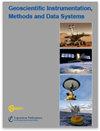Shipborne Comparison of Infrared and Passive Microwave Radiometers for Sea Surface Temperature Observations
IF 2.3
4区 地球科学
Q3 GEOSCIENCES, MULTIDISCIPLINARY
Geoscientific Instrumentation Methods and Data Systems
Pub Date : 2024-03-19
DOI:10.5194/egusphere-2024-542
引用次数: 0
Abstract
Abstract. In the spring of 2021, a shipborne comparison of sea surface temperature (SST) measurements was undertaken using Thermal Infrared (TIR) and Passive Microwave (PMW) radiometers. The Danish Meteorological Institute (DMI) and the Technical University of Denmark (DTU) jointly deployed two TIR and two PMW instruments aboard the Norröna ferry, which traversed between Denmark and Iceland for a week. The primary objective was to assess the proximity-based comparison of TIR and PMW measurements, minimizing atmospheric influences and providing valuable insights into skin (TIR) and sub-skin (PMW) SSTs. A linear regression algorithm was developed using TIR SST data as a reference to derive PMW SST from brightness temperature. The data analysis primarily focused on evaluating data variability, identifying discrepancies between TIR and PMW SST, and assessing the overall uncertainty in the retrieval process. The overall root mean squared error (RMSE) of the retrieved PMW SST was 0.88 K during the ship’s motion and 0.94 K under stable conditions when the ship was moored. The analysis of the retrieved SST error budget involved the consideration of observed quantities and a forward model, accounting for factors like instrument noise, wind speed, incident angles, and the RMSE of skin and sub-skin temperature. The resulting error budget indicated 0.97 K for the data acquired during motion and 0.34 K for data collected during port stay.船载红外和被动微波辐射计在海面温度观测方面的比较
摘要2021 年春,使用热红外辐射计(TIR)和被动微波辐射计(PMW)对海面温度(SST)测量进行了船载对比。丹麦气象研究所(DMI)和丹麦技术大学(DTU)在 Norröna 号渡轮上联合部署了两台热红外(TIR)和两台被动微波(PMW)仪器,该渡轮在丹麦和冰岛之间航行了一周。主要目的是评估基于近距离的 TIR 和 PMW 测量比较,最大限度地减少大气影响,并提供有关表皮(TIR)和亚表皮(PMW)海温的宝贵见解。以 TIR SST 数据为参考,开发了一种线性回归算法,从亮度温度推导出 PMW SST。数据分析的主要重点是评估数据的可变性,确定 TIR 和 PMW SST 之间的差异,以及评估检索过程中的总体不确定性。检索到的 PMW SST 的总均值平方根误差(RMSE)在船舶运动时为 0.88 K,在船舶停泊时的稳定条件下为 0.94 K。对检索到的海温误差预算进行分析时,需要考虑观测量和前向模型,并考虑仪器噪声、风速、入射角度以及表皮和亚表皮温度的均方误差等因素。由此得出的误差预算显示,运动期间获得的数据为 0.97 K,港口停留期间收集的数据为 0.34 K。
本文章由计算机程序翻译,如有差异,请以英文原文为准。
求助全文
约1分钟内获得全文
求助全文
来源期刊

Geoscientific Instrumentation Methods and Data Systems
GEOSCIENCES, MULTIDISCIPLINARYMETEOROLOGY-METEOROLOGY & ATMOSPHERIC SCIENCES
CiteScore
3.70
自引率
0.00%
发文量
23
审稿时长
37 weeks
期刊介绍:
Geoscientific Instrumentation, Methods and Data Systems (GI) is an open-access interdisciplinary electronic journal for swift publication of original articles and short communications in the area of geoscientific instruments. It covers three main areas: (i) atmospheric and geospace sciences, (ii) earth science, and (iii) ocean science. A unique feature of the journal is the emphasis on synergy between science and technology that facilitates advances in GI. These advances include but are not limited to the following:
concepts, design, and description of instrumentation and data systems;
retrieval techniques of scientific products from measurements;
calibration and data quality assessment;
uncertainty in measurements;
newly developed and planned research platforms and community instrumentation capabilities;
major national and international field campaigns and observational research programs;
new observational strategies to address societal needs in areas such as monitoring climate change and preventing natural disasters;
networking of instruments for enhancing high temporal and spatial resolution of observations.
GI has an innovative two-stage publication process involving the scientific discussion forum Geoscientific Instrumentation, Methods and Data Systems Discussions (GID), which has been designed to do the following:
foster scientific discussion;
maximize the effectiveness and transparency of scientific quality assurance;
enable rapid publication;
make scientific publications freely accessible.
 求助内容:
求助内容: 应助结果提醒方式:
应助结果提醒方式:


